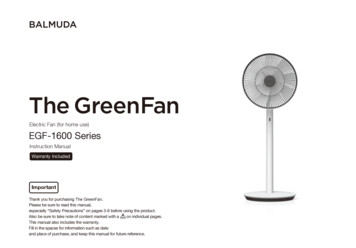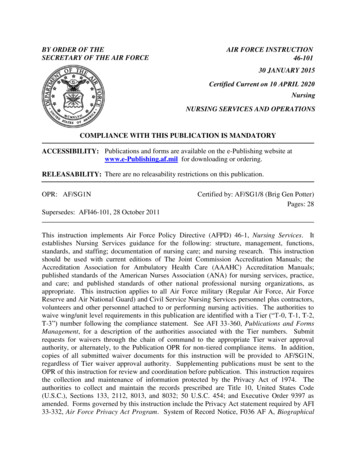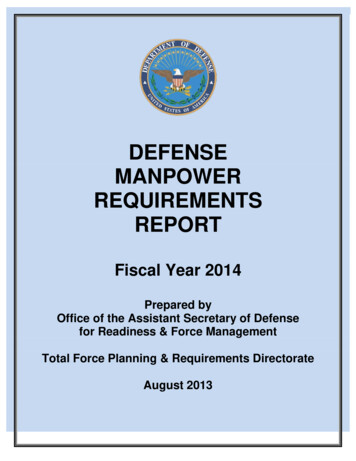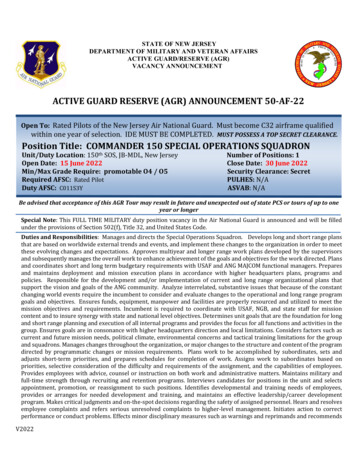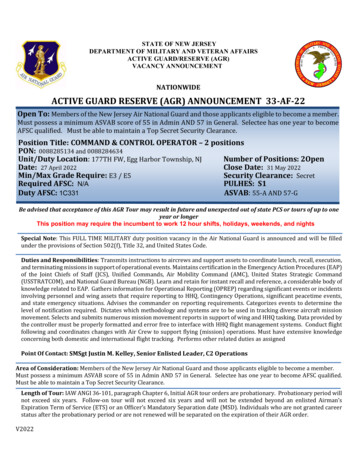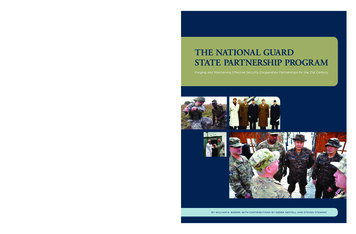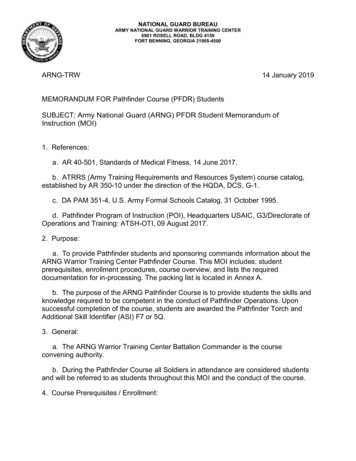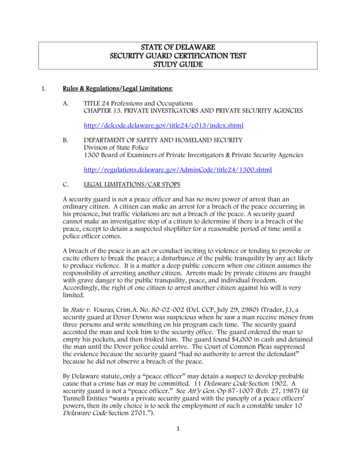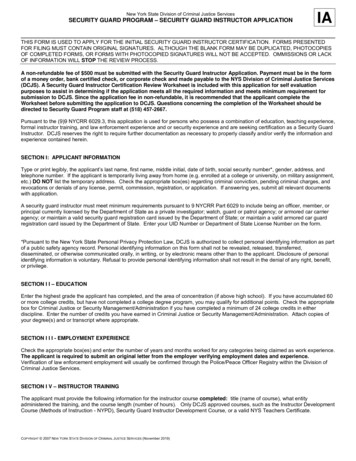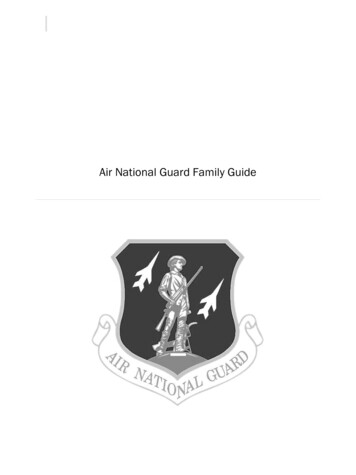
Transcription
Air National Guard Family Guide
Air National Guard Family GuideDesigned, written, and edited by:Erin BartleyRachel BeachyMegan CoffmanKatie EntnerEmily KatherineJohn Michael MummeWith special thanks to:Dr. Melissa FaulknerMrs. Monique Muncy2
Air National Guard Family GuideChapter 1: Welcome to the Air National GuardHistory of the Air National Guard . 8Structure of the Air National Guard . 8Missions of the Air National Guard . 9Air National Guard Symbols . 10Chapter 2: Life in the Air National GuardTRICARE . 14TRICARE Dental Program. 17Life Insurance . 18Health and Wellness Center . 19Identification (ID) Cards . 19Legal Services . 20Financial Information for Air National Guard Members . 22Living Within the Military Community . 30Flag Etiquette . 45Chapter 3: Managing DeploymentPersonal Resilience . 48Emotional Preparedness . 49Helping Children Cope . 50Talking to Children about Deployment . 51Conversation Points . 51Children‘s Reactions to a Military Separation . 52Grief by Developmental Stages . 53Positive Impact of Deployment on Children . 54Spouse Management of Deployment . 54KISMIF: Keep it Simple, Make it Fun . 58Special Concerns . 58The Family Readiness-Hearts Apart Program . 59Managing Pre-deployment . 61Being Prepared for Deployment . 63Planning for Emergencies . 633
Air National Guard Family GuideDisaster Preparation . 64Relocation during Deployment . 65Pre-deployment Checklist . 66Managing Deployment. 68Keeping in Touch . 68American Red Cross . 73Emergencies in the Deployed Theater . 73Security Issues . 74Positive and Negative Impact of Deployment . 75A Special Note for Stepparents . 76Force Protection Conditions . 77Military OneSource . 78Identification Cards for Military Family Members . 78Managing Post Deployment . 79Reunion: Finally Coming Home . 80Re-integration. 83Employer Support of the Guard and Reserve . 84Chapter 4: When Bad Things HappenPost-Traumatic Stress Disorder . 86Wounded Warriors . 87Suicide Prevention . 92AppendicesAcronym . 95Air Force Rank Abbreviations . 103Major Air Force Bases Around the World . . . . 104Air National Guard Bases . 106Family Programs . 115Youth Programs . 115Service Member Programs . 116Useful Websites . 1164
Air National Guard Family GuideTo our Guard family and friends,The four of us hope you find this Family Guide to be helpful and productive. Many hours and a lot ofcare went into creating what we feel is a great quick reference guide for you. We know even when youlive the Guard life every day, there is information you want and can’t find, or need and don’t knowwhere to look. As Guard members and spouses we know the system, but also know there are newbenefits and support opening up every year. As Guard parents, we know that you have special needsand questions also. Again, this Family Guide should help you to navigate the waters to find smoothsailing. We’ll see you and your families around the country. Thank you for all you do for this nationand your state.Employer support, TRICARE modifications, and family readiness changes will continue to ebb and flowwith funding. Lots of organizations and people want to help, some just aren’t sure how. We hope thisguide will help you weed through and find links to address your personal situations. Our U.S. fightingforce is "less than one percent" of the U.S. population. To all of our Citizen-Soldiers/Airmen, ournation’s finest and to the families who care for them, you are this nation’s true heroes.5
Air National Guard Family Guide6
Air National Guard Family GuideChapter 1: Welcome to the Air NationalGuardI am an American Airman.I am a Warrior.I have answered mynation’s call.
Air National Guard Family GuideGeneralWelcome to the Air National GuardIf you are reading this book, chances are you know, are related to, are married to, or arean Air National Guardsman. You and your family may have had years of experience in theAir National Guard (ANG), or you might have just jumped into the world of military life.Before you get into the rest of this guide, you should have a basic understanding of whatthe Air National Guard is, where it comes from, how it operates, and how thesedistinctions will affect you.History of the Air National GuardBefore the Revolutionary War, the thirteen original colonies each had militia forces,military groups of ordinary citizens who would be ready to fight if conflict arose. The militiaplayed a key role in starting and winning the Revolutionary War, and after the war, theU.S. Constitution said Congress would continue to provide a militia, now called theNational Guard.Militia units fought in the Civil War—unitswho fought for both North and South stillexist today—but it wasn‘t until the NationalDefense Act of 1916 that the NationalGuard was officially named the main reserveforce for the United States Army. DuringWWI, Guard units made up forty percent ofthe total units that went into combat, andduring WWII, Guard units fought in everymajor theater of the war. One Guarddivision, the 29th, even fought at D-Day.The name ―National Guard‖ wasfirst used in America in 1825 by aNew York militia unit to honor thevisit of the Marquis de Lafayette, aFrenchman and a RevolutionaryWar hero who had also commandedthe Paris militia, called the ―GardeNationale de Paris,‖ during theFrench Revolution.The first Guard unit to fly was the New York 1st Aero Company in 1911; other unitsfollowed soon after. On September 18, 1947, the Department of the Air Force wascreated, and the Air National Guard was formed to be a reserve component for the AirForce, just as the Army National Guard was for the U.S. Army.Structure of the Air National GuardThe Air National Guard (ANG) is part of both the National Guard and the Air Force. As partof the National Guard, the ANG falls under the administration of the National GuardBureau and is funded by the federal government. The National Guard functions under alaw called Title 32, which dictates how long Guardsmen serve, how they are paid, andwhat duties they can be assigned. In addition, there are approximately 1100 Air National8
Air National Guard Family GuideGuard members in Title 10 status, which means they are managed like active dutymembers.GeneralThe ANG is also a reserve component of the Air Force, and during deployment (or activeduty), Guard units report to the Air Force command. The ANG and the Air Force Reserveare both reserve components of the Air Force, but while the Air Force Reserve alwaysreports to the active Air Force command who report to the President, the ANG at timesreports to the governor of the unit‘s state or territory. For more information and newsabout the Air National Guard, go to www.ang.af.mil.Posse comitatusThis Latin phrase means ―force of the country‖ and refers to when the federalgovernment uses the armed forces as a police force, something prohibited inthe United States. The Posse Comitatus Act of 1878 limits the power of thefederal government to use the armed forces to execute laws (the job of apolice force) on U.S. soil. This act creates one of the main differencesbetween the ANG and the Air Force because when National Guard units areunder state control, they are exempt from this act and can be called on insituations where the armed forces cannot.Missions of the Air National GuardThe Air National Guard has both a state mission and a federal mission. As part of its dualmissions, Guardsmen are members of both their state‘s National Guard and the NationalGuard of the United States.Federal Mission:According to the Air Force website, the federal mission of the ANG is to maintain welltrained, well-equipped units ready to mobilize during war or national emergencies. ThePresident can call up the National Guard (Air or Army) to serve in domestic disputes, likePresident Eisenhower did in 1957 when he called the Arkansas Army National Guard tohelp desegregate Little Rock Central High School. Guard units can also be called to servein foreign conflicts or to aid in foreign emergencies such as the 2011 earthquake inJapan.State Mission:When they are not on duty with the federal government (referred to as active duty), ANGunits report to the governor of their state or territory (or, in the District of Columbia, to thegeneral of the District of Columbia National Guard). Governors can call on the ANG toassist in natural disasters or perform other functions like subduing riots. NationalGuardsmen were among the first to begin relief efforts after Hurricane Katrina hitMississippi and Louisiana.9
Air National Guard Family GuideGeneralAir National Guard SymbolsLike any branch of the military, the Air National Guard has its own symbols to represent its missionand values. Since the ANG falls in part under the command of the Air Force, it also shares the AirForce‘s vision, core values, and some of its decorations and ranking.Air Force SymbolThe Air Force symbol honors the heritage of the Air Force‘s past and represents the promise of itsfuture. The stylized wings represent the enlisted men and women of its force, the Air Force‘sstrength. The six sections the wings are divided into represent the six core competencies of the AirForce—aerospace superiority, global attack, rapid global mobility, precision engagement,information superiority, and agile combat support.The lower section of the symbol has a circle, a star and three diamonds. The circle represents theglobe and the Air Force‘s vision to secure our nation‘s freedom with global vigilance, reach, andpower. The star represents the officer corps, which is central to the Air Force‘s combat leadership,as well as space, the height of the Air Force‘s reach. The five points of the star also represent fivecomponents of the Air Force: active duty, civilians, Air National Guard, Air Force Reserve, andretirees. The three diamonds represent the core values of the Air Force: ―integrity first, servicebefore self, and excellence in all we do.‖The Air National Guard‘s unofficial circular emblem was adopted in 1963 and was replaced by theshield showing the mission aircraft in 1973. The official symbol with the Minuteman was approvedin 1989. The figure of the Minuteman was based on Daniel Chester French‘s original sculpturededicated at Concord, Massachusetts in 1875. The Minuteman is dressed in period civilian clothesand firmly gripping a musket in his right hand, the minuteman stands with a plow at the calf of hisleg. In profile, he scans the horizons with a determined expression. Framing the figure are twosoaring missiles. The emblem reflects the Air National Guard‘s history. The minuteman personifiescitizen patriots who have always rallied in time of national peril. The musket is a symbol ofreadiness to defend home and country. The plow at the calf of his leg represents ties to the landand the missiles graphically portray potential power.10
Air National Guard Family GuideAir National Guard ShieldGeneralThe Airman’s CreedI am an American Airman.I am a Warrior.I have answered my nation‘s call.I am an American Airman.My mission is to fly, fight, and win.I am faithful to a proud heritage,A tradition of honor,And a legacy of valor.I am an American Airman,Guardian of freedom and justice,My nation‘s sword and shield,Its sentry and avenger.I defend my country with my life.I am an American Airman;Wingman, Leader, Warrior.I will never leave an Airman behind,I will never falter,And I will not fail.11
Air National Guard Family Guide12
Air National Guard Family GuideChapter 2: Life in the Air National GuardI am an American Airman.My mission is to fly, fight,and win.I am faithful to a proudheritage,A tradition of honor,And a legacy of valor.13
Air National Guard Family GuideHealthcare Coverage for ANG MembersTRICARETRICARE is the healthcare coverage system for the Air National Guard and has threelevels: Standard, Extra, and Prime.EligibilityLife in the ANGTRICARE is available for active duty Guard members and their family members. Active Guard members are eligible for TRICARE Prime if they serve on active dutyfor at least thirty consecutive days. To be eligible for TRICARE Prime, Guardmembers must live within fifty miles of a military treatment facility also called theprime service area. If you live outside the prime service area, you become eligiblefor TRICARE Prime Remote.Family members are eligible for TRICARE Standard and Extra if the Guardmember serves on active duty for at least thirty consecutive days. TRICARE Primebecomes available to you if the Guard member serves on active duty for at least180 days and is only available if you live within fifty miles of a military treatmentfacility, also called the prime service area. If you live outside the prime servicearea, you become eligible for TRICARE Prime Remote.TRICARE recognizes you as a family member if you are the spouse, child of any age withsevere mental or physical handicaps, or an unmarried child up to the age of 21 (extendedto the age of 23 if you are a full-time student). TRICARE may also recognize dependentparents.Your TRICARE coverage at any of the three levels ends at midnight on the last day of theGuard member‘s active duty service.All eligibility for Guard members and your family members is determined through theDefense Eligibility Enrollment Reporting System (DEERS). When the Guard member goesonto active duty for at least thirty consecutive days, DEERS automatically processesTRICARE eligibility for the Guard member and all family members previously registeredwith DEERS. It is highly recommended that you check to make certain that all informationwith DEERS is accurate and current.EnrollmentThe first step to enrolling for TRICARE is to obtain valid identification (ID) cards. ID cardsare available for family members (see Eligibility for who are recognized as familymembers), and temporary ID cards can be given to guardians of dependent children.Every child who is ten years or older must have an ID card. ID cards can be obtained atany ANG base or Army Guard Armory.14
Air National Guard Family GuideWhen the military member applies for an ID card, make certain you also register alleligible family members with DEERS.After obtaining ID cards, make certain that all information is accurate and current withDEERS. Guard members will need to contact a DEERS RAPIDS location and requestenrollment of family members in DEERS and provide documentation as instructed by theDEERS/RAPIDS site manager.If your Guard member serves for a minimum of 180 days, your family members becomeeligible for TRICARE Prime. You must enroll family members for TRICARE Prime bycompleting a TRICARE Prime Enrollment Application and presenting the Guard member‘sSocial Security Number. It is also important that family members have a copy of theGuard member‘s service orders for active duty.TRICARE Prime Remote is for Guard members and their family members that live outsidethe prime service area. Guard members are automatically enrolled in TRICARE PrimeRemote, and family members will be enrolled in TRICARE Prime Remote when theTRICARE Prime Enrollment Application is completed.TRICARE Reserve Select (TRS) is available to Selected Reserve members of the ReadyReserve, as well as their families and survivors. TRS benefits are similar to TRICAREStandard and Extra. Contact your local TRICARE Service Center for more informationabout eligibility and benefits.Note: TRICARE Prime has the application constraint called the ―20 th of theMonth Rule.‖ If your TRICARE Prime Enrollment Application is receivedthrough the twentieth, your enrollment will become effective the first day ofthe following month. If your TRICARE Prime Enrollment Application isreceived after the twentieth, your enrollment will become effective the firstday of the second month after your application is received. For example, ifyour application is received June 1-20, your enrollment will become effectiveJuly 1. If your application is received June 21-30, your enrollment will notbecome effective until August 1.15Life in the ANGDecide which level of TRICARE your family will use. Guard members are automaticallyenrolled in TRICARE Prime when they serve on active duty for a minimum of thirtyconsecutive days, and your family members are automatically enrolled with TRICAREStandard or Extra.
Air National Guard Family GuideBenefitsEach level of TRICARE has its own benefits. Life in the ANG TRICARE Standard gives the greatest flexibility in choosing your own healthcareproviders, and it costs the most. TRICARE Standard allows family members toremain with their current civilian providers and offers treatment at both militaryand civilian facilities. At military facilities, family members on TRICARE Standardare seen on the basis of what space and facilities are available at the time.TRICARE Extra provides a selection of pre-approved civilian providers that youmay choose from. The cost is lower, and you do not have to file claims. TRICAREExtra offers treatment at both military and civilian facilities and receives greaterpriority than TRICARE Standard.TRICARE Prime offers a selection of pre-approved civilian providers that you maychoose from. This level costs the least, has no deductibles or co-payments, andthe network submits claims for you. TRICARE Prime receives priority at militaryfacilities, with access standards that ensure care to all beneficiaries. Accordingto the access standards for TRICARE Prime, emergencies must be seenimmediately if services are available, urgent care must be seen within twentyfour hours, routine visits must be seen within one week, and wellness andspecialty visits must be seen within four weeks.TRICARE Prime assigns a primary care manager (PCM) to you, to whom you go for all nonemergency care. The PCM also authorizes and issues a referral for specialty care whennecessary.Military treatment facilities will prioritize the order in which they see patients based uponyour TRICARE level:1. Guard members serving on active duty2. Family members of Guard members serving on active duty with TRICAREPrime3. Anyone with TRICARE Standard and ExtraFamily members may choose to see their own doctors, but TRICARE becomes thesecondary insurance and the deductibles and co-payments increase.16
Air National Guard Family GuideAdditional Coverage under TRICAREExams and Prescriptions TRICARE Dental ProgramDental coverage is provided to your Guard member and family members by the TRICAREDental Program (TDP), which is administered by United Concordia Companies, Inc. (UCCI).Enrollment is completely voluntary, and the TDP requires a monthly premium.EligibilityThe TDP is available to Guard members and their family members (see TRICARE Eligibilityfor a description of recognized family members). Guard members serving on active duty are not eligible to enroll in the TDPbecause their dental care is provided through a military dental treatment facility(DTF).When family members enroll, the Guard member must have at least twelvemonths remaining on their active duty orders, because family members becomelocked into the TDP for a twelve-month period when they enroll. An exception isallowed for family members who lose eligibility in DEERS during the twelve-monthperiod.If the Guard member serves on active duty for a minimum of thirty days, familymembers may become eligible to receive treatment from the DTF. The DTFprovides treatment to family members only as space and facilities are available.Eligibility is determined by DEERS (see TRICARE Eligibility and Enrollment formore information on DEERS).17Life in the ANGEye Exams: Only TRICARE Prime covers routine eye exams, and it offers familymembers an examination once every two years. Contact lenses and glasses arenot covered by TRICARE. Prescriptions: All prescriptions received on base are free of charge. A co-paymentis required for prescriptions obtained from an off - base pharmacy. Traveling: If any emergencies, urgent care, or hospitalizations occur whiletravelling, you must contact TRICARE within twenty-four hours. The toll freenumber is on the back of your card. If you have to pay for a prescription whiletraveling, you must submit a claim for reimbursement from TRICARE.For further information about benefits and costs, contact your local TRICARE ServiceCenter.
Air National Guard Family GuideEnrollmentEnrollment in the TDP is completely voluntary.Families may choose to maintain coverageunder a civilian employer.Life in the ANGThe UCCI‘s TDP contract administrator handlesenrollment in the TDP. To enroll, you mustcontact either the nearest TRICARE ServiceCenter or a military dental treatment facility.The UCCI processes the TDP applicationsaccording to the ―20th of the Month Rule‖ (seethe Note under TRICARE Enrollment).What happens to enrollment if the Guardmember is ordered to active duty? Any Guard member who is ordered to active duty while enrolled in the TDP will bedis-enrolled from the TDP and will begin receiving care through the DTF.If your family members are already enrolled in the TDP when the Guard memberis ordered to active duty, their coverage will continue and the premium will beadjusted to the active duty family rates.If your family members are not already enrolled in the TDP when the Guardmember is ordered to active duty, you may enroll while the Guard member hastwelve months remaining on their active duty orders, because family membersbecome locked into the TDP for a twelve-month period when you enroll.BenefitsThe TDP completely covers all diagnostic, emergency, and preventive services, except forsealants. The TDP partially covers fillings, root canals, sealants, crowns, extractions,orthodontics, and general anesthesia that is connected with a service already covered.You may choose from a selection of pre-approved dentists provided by the TDP. You mayalso decide to see a dentist outside of the approved network, but there will be additionalfees.Guard members receive care through the DTF based on the space and facilities that areavailable. Resources are generally limited for the DTF, so it is hard for family members toreceive care from the DTF.Life InsuranceServicemembers‘ Group Life Insurance (SGLI) is offered to all members of the ANG. SGLIis low-cost and automatically offers all members the maximum coverage, unlessrequested in writing to receive less. Family Servicemembers‘ Group Life Insurance (FSGLI)18
Air National Guard Family Guideis also automatically available for family members. With FSGLI, family members‘ coveragecannot exceed the amount of coverage the Guardsman receives under SGLI.Service members, who are enrolled in SGLI, are also covered by Traumatic SGLI (TSGLI)which offers payment of up to 100,000 to the service member if he or she suffers atraumatic injury resulting in loss of activities of daily living (ability to bath, dress, etc.) orsuffers any other qualifying loss under the Office of Serviceman's Group Life InsuranceTSGLI schedule. More information is available online at: www.insurance.va.gov. Formore information, contact your OSGLI.The Health and Wellness Center (HAWC) provides services that enhance health throughhealth and fitness assessments, classes and programs that teach awareness andprevention, and exercise programs. The HAWC is available for any Guard member, familymember, retiree, and civilians employed on active duty bases. Non co-located ANG baseshave Wing Fitness facilities. Some of the specific services provided include tobaccocessation classes, weight loss counseling, stress and anger management classes, andblood pressure and cholesterol counseling.Legal Information for ANG MembersIdentification (ID) CardsIdentification (ID) cards are required by the Department of Defense (DoD) for eachmember of the family. ID cards are necessary for access to benefits and privileges duringboth peacetime and mobilization. ID cards are essential to obtain military healthinsurance under TRICARE when a Guard member serves on active duty (see the sectiontitled Enrollment under Medical‘s TRICARE).Family members who are eligible for ID cards include: SpouseWidow or widowerUnmarried children who are ten to twenty-one years of ageChildren under ten years of age who do not live with the Guard memberChildren of any age who have severe mental or material disabilitiesUnmarried children up to twenty-three years of year who attend school full-timeParents or in-laws who are dependent on the Guard member19Life in the ANGHealth and Wellness Center
Air National Guard Family GuideLife in the ANGEligibility for ID cards can be established with any of the following: Marriage certificatesAdoption papersBirth certificatesPaternity papersDivorce papersDeath certificatesA statement of mental or physical disability for dependent children, signed by alicensed physician or medical officerA certificate from the school registrar of a child enrolled full-time in collegeLegal ServicesLegal Assistance OfficesLegal assistance offices are available on all active military installations and offerassistance to military families. ANG bases have part-time legal assistance staff. Theseoffices are generally operational on drill weekends. Legal assistance offices generallyprovide assistance with wills, powers of attorney, child support, and family matters. Legalassistance officers can also negotiate for family members, but they cannot
The Air National Guard (ANG) is part of both the National Guard and the Air Force. As part of the National Guard, the ANG falls under the administration of the National Guard Bureau and is funded by the federal government. The National Guard functions under a law called Title 32, which dictates how long Guardsmen serve, how they are paid, and
